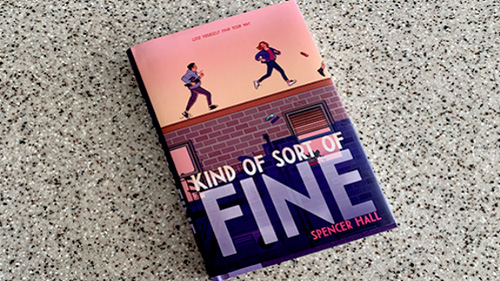Halloweenie Books
October is spooky month so what better way to embrace the season than books with mutant teenagers, witches, vampires, and more! Michael Guevara...
AP & Honors Mathematics
Explore Wiley titles to support both AP and Honors mathematics instruction.
Literacy Skills & Intensive Reading
Connections: Reading – Grades 6–12
Empower student success with a proven intensive reading program that develops strong reading skills in striving readers.
Drama, Speech & Debate
Basic Drama Projects 10th Edition
Build students’ confidence and competence with comprehensive, project-based theatre instruction.
Literature
Connections: Literature
Support learners as they study dynamic, relevant texts and bring the richness of diverse voices to students through literature.
Literature & Thought
Develop critical thinking, reading, and writing across literacy themes, genres, historical eras, and current events.
Language Arts
Vocabu-Lit® – Grades 6–12
Help students build word power using high-quality contemporary and classic literature, nonfiction, essays, and more.
Connections: Writing & Language
Help students develop grammar, usage, mechanics, vocabulary, spelling, and writing and editing skills.
Reading/English Language Arts
Measuring Up to the English Language Arts Standards
Incorporate standards-driven teaching strategies to complement your ELA curriculum.
English Language Learners
Measuring Up for English Language Learners
Incorporate research-based best practices for ELLs with an approach that includes a focus on language acquisition strategies.
Mathematics
Measuring Up to the Mathematics Standards
Incorporate standards-driven teaching strategies to complement your mathematics curriculum.
Foundations
Measuring Up Foundations
Help students master foundational math skills that are critical for students to find academic success.
Science
Measuring Up to the Next Generation Science Standards
Give students comprehensive NGSS coverage while targeting instruction and providing rigorous standards practice.
Assessment
Measuring Up Live
Deliver innovative assessment and practice technology designed to offer data-driven instructional support.
For a better website experience, please confirm you are in:
As secondary English teachers, we know how important it is for our students to learn to write well. We also know that oftentimes means we have over a hundred papers to grade.
So how can we provide meaningful feedback for our students without stretching ourselves too thin?
I’ve got a few “tricks” that have helped me streamline my grading process over the years. Let me share them with you!
As a novice teacher, I’m pretty sure I assigned three essays in the first nine-week marking period. It felt like I was drowning in a pile of papers, and I found myself writing the same feedback from one paragraph to the next, one paper to the next.
Did my students grow as writers that year? Yes.
Was there an easier way to achieve the same result? Also yes.
I realized that many of the comments I was writing could be addressed in shorter assignments. If students were able to master these concepts in a short assignment I could grade more quickly, they’d get their feedback more quickly, and they’d be better prepared for the summative assessment.
Examples of Shorter Writing Assignments for High School ELA
In my classes, we often read multiple shorter works of nonfiction in a unit, so I’ll have students practice writing a thesis statement to demonstrate their knowledge of what we discussed in class. For subsequent texts, I have students write a body paragraph or an outline.
Shorter writing assignments reveal quite a bit about a student’s writing style and comprehension. They are a great formative assessment to help guide instruction.
Repeat after me: “I am not my students’ editor.”
I’ve had to remind myself of that plenty of times.
Now, don’t get me wrong. I’m not saying you should never comment on grammar or spelling, but I do think it’s important to keep the objectives of the assignment in mind.
When providing feedback on student writing, I have adopted the “glow and grow” feedback method.
A “glow” is something that the student has done well.
Over the years, I’ve had dozens of students tell me “I’m not a good writer.” When they receive an assignment back, their eyes first dart to the grade, then the comments. Their shoulders relax a little bit as they realize they’ve received some positive feedback. After all, who wants to put effort into a writing assignment and receive just a grade? Or worse, a list of all their mistakes?
Grading papers can be tiresome—personally, I grade a handful assignments at a time and take a quick break—but when providing the “glow” feedback, I try to push myself to leave a meaningful “glow,” not just a “good job!” I might start with “good job” but I try to add a sentence or two of specific praise.
Over the years, I’ve found that by starting my feedback, especially for essays, with a “grow” helps boost student confidence and makes them more receptive to considering or implementing the “grow” feedback.
For “grow” feedback, I focus on content—typically the top two “things” I want the student to work on. I also try to ask questions or provide examples of how to tackle these issues because simply writing “add more commentary” isn’t always very helpful. If students knew how to add more commentary, for example, they likely would have. They might need guidance about what to say, or it might help to call their attention to the commentary that is working well, so they know what to expand on.
“Grow” feedback can include grammar feedback too, especially if it is a topic you’ve covered in class. As with the content feedback, I recommend selecting a single aspect to focus on. If students are given too many corrections, they can become overwhelmed.
Have you ever wanted to leave students some feedback on their writing but felt as though it was too much to type or maybe it would be unclear or maybe students might misunderstand your tone?
In these situations, the Google extension Mote is a wonderful way to leave quick, personalized feedback in Google Classroom.
After installing Mote—which is really easy, by the way—you can highlight a portion of text on the Google doc and add a voice note. Doing so allows you to leave line-level feedback about specific phrases or sentences. You can also use Mote to add a voice note in the private feedback section of Google Classroom, which is great for overall feedback.
But what about those situations where you are writing the same feedback over and over again?
In these situations, the comment bank in Google Classroom comes in handy.
To add to the comment bank, toggle from “grading” to “comment bank” and add the comment. From there, you can copy the comment and paste it into the private comments. You’re still providing your students with necessary feedback, but you’re also saving yourself time.
Don’t have Google Classroom? No problem! You can make your own comment bank on a separate doc so you can copy and paste from there.
These three tips have helped me streamline my grading process while still providing my students with meaningful assignments and feedback to help them transform their writing.
Happy teaching!
Beth Hall earned her MFA in Creative Writing in 2014, and then began her career as a high school English teacher, quickly finding a passion for teaching nonfiction and helping students hone their writing skills.
In 2019, she began a YouTube channel called Coach Hall Writes as a medium to allow her to supplement her students’ instruction outside the classroom. Hall’s videos quickly gained notoriety among AP® Language and Composition teachers and students because of the videos’ conciseness and clarity. In 2020, the Coach Hall Writes YouTube Channel was listed as one of the top resources AP Lang teachers felt was most helpful in preparing their students for the AP® Language and Composition exam.

October is spooky month so what better way to embrace the season than books with mutant teenagers, witches, vampires, and more! Michael Guevara...

A bright part of every teacher’s day is getting to the class that your star student is in. You know the one. We see them reach for the sky every time...

With 45 questions in an hour, four answer choices per question, it’s understandable why the multiple-choice section can be intimidating.

The teaching of AP® World History can be a daunting task at times. Teachers are asked to teach over 800 years of historical content and then develop...
.jpg)
Happy Halloween week! For those wanting to sprinkle a little Halloween spirit into the classroom this week, the attached lesson plan uses the novel ...

Join Brandon Abdon, Timm Freitas, and Beth Hall as they celebrate their new book–AMSCO's Writing for the AP Exam: English Language and Composition....

Join Dr. Brandon Abdon and partners in AP Lang Timm Freitas (Garden Of English) and Beth Hall (Coach Hall Writes) to discuss their top tips for...

If you read my previous blog post, The Most Foundational Document: The U.S. Constitution, you'll have noticed a classroom activity for the...

Back in the days before television screens were flat, before we had televisions in every room of the house, before crazy high screen resolutions let...

In the first blog post of the Rhetoric Meets Remedy series, I discussed the importance of teaching for transfer. Teaching for transfer is vital...

One of the key shifts in English Language Arts classrooms is the move for students to engage routinely with complex text. To prepare students for the...

For some reason, students always struggle when teachers ask them to incorporate sources. It is a process that takes practice to do seamlessly, but...

